Historic Washington State Park
Historic Washington State Park (formerly Old Washington Historic State Park) is a 101-acre (41 ha) Arkansas state park in Hemsptead County, Arkansas in the United States. The museum village contains a collection of pioneer artifacts from the town of Washington, Arkansas, which is a former pioneer settlement along the Southwest Trail.[2] Walking interpretive tours are available throughout the 54 buildings.[1] Washington served as a major trading point along the Southwest Trail, evolving into the Hempstead county seat and later the capital of Arkansas from 1863 to 1865 when Little Rock was threatened during the Civil War.[1] The original plat of Washington was added to the National Register of Historic Places in 1972 as the Washington Historic District.[3]
| Historic Washington State Park | |
|---|---|
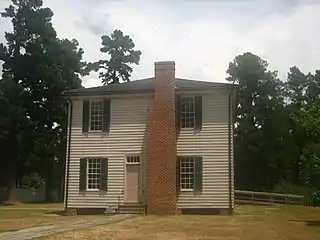 The Old State House, Washington, Arkansas | |
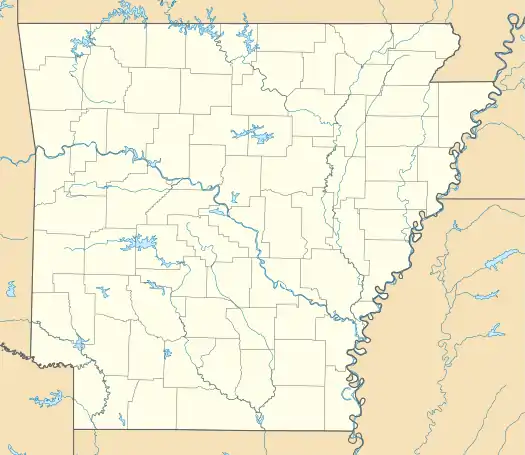 Location of Historic Washington State Park in Arkansas  Historic Washington State Park (the United States) | |
| Location | Washington, Arkansas, Hempstead, Arkansas, United States |
| Coordinates | 33°46′25.6″N 93°41′2.6″W |
| Area | 101 acres (41 ha)[1] |
| Established | July 1, 1973[1] |
| Governing body | Arkansas Department of Parks and Tourism, Pioneer Washington Preservation Foundation |
| Website | Historic Washington State Park |
During the 1820s and 1830s, Washington was a stopover for travelers going to Texas. It was originally the county seat of Hempstead County until a new courthouse was completed in Hope, which was designated the seat of government in 1939. The park emphasizes regional 19th century history from 1824 to 1889.[4] It is located in southwestern Arkansas east of Texarkana and near the entrance to Interstate 30.
History of Old Washington
The Southwest Trail ran from St. Louis, Missouri, to the Red River port of Fulton in Hempstead County some twelve miles from Washington. At the time, the Red River was the border between the United States and Mexico. The trail was a route taken by people headed to Mexican Texas. William B. Travis, Sam Houston, and Davy Crockett each separately traveled through Washington on their way to Texas. In the early 1830s until the 1840s, bands of Cherokee and Choctaw travelled through Old Washington on their way to Indian Territory under the Indian removal policies of U.S. President Andrew Jackson. In 1846, Washington was a mustering point for Arkansas troops marching south to fight under General Zachary Taylor in the Mexican War.[1]
On February 14, 1820, Washington was authorized for a post office. That facility remains the oldest continuous postal operation west of the Mississippi River. A new postal building was dedicated on May 29, 1988, by then U.S. Senator David Hampton Pryor.[5] Washington became a town on George Washington's birthday, February 22, 1824.[2]
From 1863-1865, Old Washington was the site of the Confederate capitol of Arkansas after the fall of Little Rock to Union forces. The original Arkansas Confederate capital, where the refugee government fled, still exists in the park. It is a part of the Camden Expedition Sites, named in part for the town of Camden, Arkansas, in southern Arkansas.
In the early 1864, Washington was threatened by Union forces under the command of Major General Frederick Steele which moved south along the Military Road en route to Shreveport, Louisiana. A Confederate force under the command of Major General Sterling Price blocked Steele's army. The two forces engaged in battle on April 10, 1864, some fourteen miles north of Washington. Steele was forced to move east to Camden, a movement which spared Washington from invasion. This encounter was known as the Skirmish at Prairie D'Ane. Many wounded soldiers were brought to Washington for medical treatment. Several buildings, including the Washington Baptist Church, were turned into hospitals to treat the wounded. Seventy-four unknown Confederate soldiers from this battle were buried in a mass grave in the Washington Presbyterian Cemetery.[1]
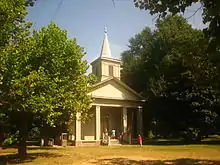
In the early 1870s, the Cairo and Fulton Railroad built a line through southwest Arkansas which bypassed Washington. Instead the depot was nine miles away and became the origin of the city of Hope, incorporated on April 8, 1875. Fire swept through Washington on July 3, 1875 and destroyed much of the business district. A second fire occurred on January 21, 1883. Most of the businesses in Washington relocated to Hope, which proposed that it supersede Washington as the county seat. Several fraudulent elections were held over the matter. The Arkansas Supreme Court intervened and, in a ruling in May 1939, declared Hope the county seat.[1]
In 1958, the Pioneer Washington Restoration Foundation began preserving the unique buildings and sites that currently lie within the park. The park was established in 1965 and opened eight years later. The Southwest Regional Archives was established there in 1978. Since that time, more than 200,000 artifacts related to 19th century life have been recovered in the park and is the site of ongoing archaeological research on small-town life.
The historic buildings provide excellent examples of the architectural styles popular in the 19th century American South. Examples on display are Southern Greek Revival, Federal architecture, Gothic Revival, Italianate, and the rough-hewn timber or brace-frame construction of the frontier.
Visitors follow plank board sidewalks along streets that have never been paved. The largest magnolia tree in Arkansas, planted in 1839, also graces the town. Everything within the original 1824 boundaries of the town are listed on the National Register of Historic Places.
Major buildings
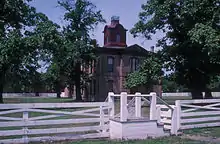
Park tours begin at the previous Hempstead County Courthouse, which was constructed in 1874 and is maintained as the museum headquarters and visitors center. On the top floor, one may meditate in the courtroom where trials and hearings were formerly held. After the county seat was moved to Hope, the 1874 courthouse was used as a school beginning in 1914. A gym was built during the 1930s by the Works Progress Administration. Both are still used for meeting rooms and group rental facilities.[1]
- John Dyer Trimble House – Heirs of John D. Trimble donated their family home and furnishings to the museum in 1978. The artifacts highlight three generations who lived in the house in Hempstead County.
- Clardy/Goodlet Kitchen – This detached structure is believed to be one of the last original such kitchens in the state.
- Royston Log House – A demonstration of living in the 1830s–1860s. A guide shows visitors what materials and tools were essential to build a log house during the previous century.
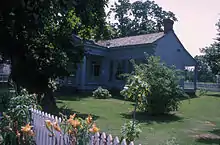
- Crouch House – A Greek revival home constructed by Augustus M. Crouch, a jeweler and watchmaker who served in the Mexican War at the Battle of Buena Vista in 1847. This structure was located on museum grounds in 1980 at the site of a similar house which burned in 1903.[4]
- B.W. Edwards Weapons Museum – A former bank houses a collection of weapons assembled by Basil W. Edwards, a local resident. The exhibit includes muskets, rifles, shotguns, matchlocks, flintlocks, revolvers, and Bowie knives.[6] The weapons museum also includes an exhibit on Thomas Hamilton Simms (1838—1919), who served with the Hempstead Rifles at the Battle of Wilson's Creek near Springfield, Missouri, early in the Civil War.[7]
- Washington Print Museum – Interprets printing equipment and techniques from the late 19th and early 20th centuries. The print shop is also run by Gary White.
- 1836 Courthouse - The original Hempstead Courthouse was in 1844 the scene of the first murder trial in Hempstead County. The courthouse was chosen by Governor Harris Flanagin during the Civil War as the Confederate capital of Arkansas. By 1858, Washington had outgrown the courthouse, and a new facility was proposed in 1872. When the second courthouse opened in 1874, the previous structure became the house of the county clerk. In time it was boarded up.[4]

In 1929, the United Daughters of the Confederacy secured state funding to restore the 1836 Hempstead Courthouse. This was the first restoration money ever appropriated by the Arkansas General Assembly. The building now included in Washington Park has paintings of Confederate icons J.E.B. Stuart, Stonewall Jackson, and Pierre G.T. Beauregard on the walls.[8]
In 1958, a group of Washington citizens formed the Pioneer Washington Restoration Foundation to preserve the old structures and interpret the history of Washington. They operated tours of some of the historic homes for fifteen years. In 1973, they invited the Arkansas Department of Parks and Tourism to assist in the preservation and interpretation of the village. The foundation donated property, buildings, and antiques, and Old Washington Historic State Park opened as the then thirty-fourth Arkansas state park on July 1, 1973.[1]
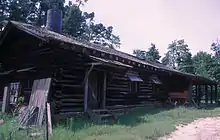
- Block-Catts House – Built by Abraham Block, a merchant in Washington, this home, elegant in its day, is a rare Federal-style structure in southwest Arkansas. Block, an immigrant from Bohemia, had twelve children. Block first came to the port of New Orleans before heading northward. He was the first Jewish settler in Arkansas. His house was the oldest in Washington and the oldest two-story residence in the state. The house had a grand piano and impressive dining hall. Block died in 1857.[4]
- Blacksmith Shop – The shop was built by the Pioneer Washington Restoration Foundation in 1960 as an interpretation center. It has two working forges. In 1831, James Black, the best known blacksmith in Washington, forged one of the original Bowie knives for the frontiersman James Bowie. The shop was dedicated to the memory of Thomas Hamilton Simms of the Hempstead Rifles.[4]
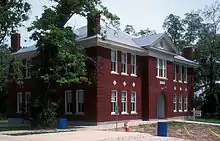
- Simon Sanders House and Urban Farmstead – A program entitled "Her Work Is Never Done" presented at the Sanders House is a demonstration of the endless tasks assigned to a household slave during the antebellum years in Washington.[4] Simon Sanders was the father-in-law of Augustus H. Garland, a Hempstead County resident who was Attorney General of the United States during the administration of U.S. President Grover Cleveland.
- Washington High School – The restoration of the 1914 school in Washington was dedicated by the State Parks, Recreation, and Travel Commission in June 2003. It is located on the far eastern end of the city. Then-Governor Mike Huckabee attended the dedication.[9]
Museum information
Surrey rides are available on special occasions. The Williams Tavern Restaurant offers country cooking. Part of the funding for Arkansas state parks such as Washington comes from a .125-cent sales tax allocated for Game/Fish and Parks/Tourism.[4]
The park provides a variety of events for local residents and visitors including demonstrations and workshops on blacksmithing, weaving, quilting, sewing, candlemaking, forging, and harness driving.
Historic Washington offers Civil War weekends and reenactments, the Five Trails Rendezvous (commemorating the origin of five Native American trails in the region) held in February, the annual jonquil festival in March, and a Christmas festival and Victorian era Christmas ball. The park is decorated for Christmas each December.[1]
At Historic Washington, the American Bladesmith Society operates the only bladesmithing college in the United States. The program, affiliated with Texarkana College, claims to be the only school in the world dedicated to the art of making knives and swords.[2]
Restoring Old Washington
Among the leading figures in the restoration of Old Washington was James H. Pilkinton of Hope, who served as president of the Pioneer Washington Restoration Foundation twice between 1959 and 1990. Others involved in the restoration are Parker O. Westbrook, a former aide to the late U.S. Senator J. W. Fulbright, and Westbrook's sister, Lucille.
Old Washington has been called the "Colonial Williamsburg of the Southwest" or "Colonial Williamsburg of Arkansas", in reference to the Colonial Williamsburg restoration in Virginia which opened in 1957 courtesy of the Rockefeller family.
Collections
Historic Washington houses the Southwest Arkansas Regional Archives which is the primary center for historical and genealogical research in the region. The archives contain rare books, court documents, newspapers, census information, photographs, scrapbooks, sheet music, and assorted family histories.[2]
Gallery
 John Dyer Trimble House at Historic Washington State Park
John Dyer Trimble House at Historic Washington State Park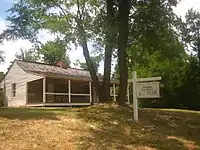 The Royston Log House at Historic Washington State Park
The Royston Log House at Historic Washington State Park Closeup of Royston Log House
Closeup of Royston Log House Largest magnolia tree in Arkansas (planted 1839) at Historic Washington State Park
Largest magnolia tree in Arkansas (planted 1839) at Historic Washington State Park Print Shop Museum
Print Shop Museum Williams Tavern is now a country restaurant at Historic Washington State Park.
Williams Tavern is now a country restaurant at Historic Washington State Park. The Block-Catts House was perhaps the most elegant of its kind in the Arkansas of 1832.
The Block-Catts House was perhaps the most elegant of its kind in the Arkansas of 1832. Grand piano at Block-Catts House at Historic Washington State Park
Grand piano at Block-Catts House at Historic Washington State Park Elegant dining table at Block-Catts House
Elegant dining table at Block-Catts House Revolver exhibit at the B.W. Edwards Weapons Museum at Historic Washington State Park
Revolver exhibit at the B.W. Edwards Weapons Museum at Historic Washington State Park Restored two-story school building at Historic Washington Park
Restored two-story school building at Historic Washington Park
See also
References
- McDade, Bryan (December 16, 2011). "Historical Washington Museum State Park". The Encyclopedia of Arkansas History and Culture. The Butler Center. Retrieved March 22, 2012.
- "Historic Washington State Park". Arkansas State Parks Guide, 2011. Arkansas Department of Parks and Tourism. p. 32. Retrieved March 22, 2012.
- "National Register Information System". National Register of Historic Places. National Park Service. July 9, 2010.
- Brochure entitled "Programs, Tours, and Activities, Historic Washington State Park, August 7, 2008
- Hope Star, Hope, Arkansas, May 30, 1988
- B.W. Edwards exhibit, Historic Washington State Park
- Thomas Hamilton Simms exhibit, B.W. Edwards Weapon Museum, Historic Washington State Park, Washington Arkansas
- Exhibit at 1836 Courthouse, Historic Washington State Park
- Exhibit at Washington High School restoration in Washington State Park
Further reading
- Kwas, Mary (2009). Digging for History at Old Washington. Fayetteville: University of Arkansas Press. ISBN 1-55728-898-4.
External links
| Wikimedia Commons has media related to Historic Washington State Park. |